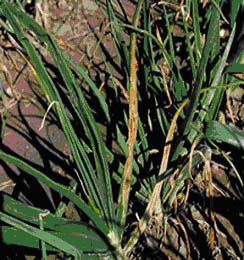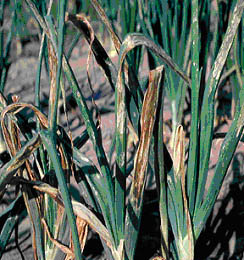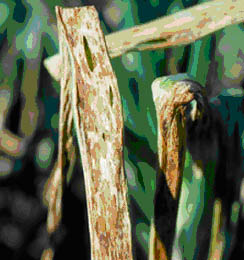by H. Schwartz and D. H. Gent * (5/11)
Quick Facts…
- Xanthomonas leaf blight is a common foliar, bacterial disease of onion.
- The disease favors moderate to warm temperatures, high moisture and plant wounds during and after bulbing.
- The pathogen can survive in infested debris and volunteer onions, and is seed-borne.
- Management options include crop rotation, sanitation, planting clean seed, transplants and sets, varietal selection, stress and wound avoidance, and proper pesticide scheduling.
Many bacterial pathogens occur throughout the onion growing areas of Colorado and surrounding states. Yield losses from bacterial pathogens including bulb size and quality) range from a trace to 100 percent, especially when adverse environmental conditions persist after bulb initiation.
In Colorado, Xanthomonas leaf blight (caused by Xanthomonas axonopodis pv. allii) is a common foliar, bacterial disease of onion. Xanthomonas leaf blight, also known as bacterial blight of onion (Allium cepa), was first described in 1978 from Hawaii, but has rapidly spread to onion and Allium production regions in the East Caribbean, continental United States, South America, South Africa, Asia, and Réunion Island, France. A very similar disease was reported on onion in the Arkansas Valley in the 1940s and 1950s, but it was not reported again or investigated until 50 years later.
 |
|
Figure1. Xanthomonas leaf blight infection of susceptible
|
|
 |
|
Figure 2. Xanthomonas leaf blight symptoms on older
|
|
 |
|
Figure 3. Xanthomonas leaf blight symptoms of onion;
|
|
 |
|
Figure 4. Xanthomonas leaf blight symptoms of onion;
|
|
Pathogen Survival
X. axonopodis pv. allii survives between susceptible crops in association with contaminated seed, infested crop debris, and epiphytically or pathogenically on volunteer onion, weed and leguminous plants. Infection occurs when aerosols or splashing water deposit X. axonopodis pv. allii onto leaves. The bacterium then multiplies to form large populations in the presence of dew or other moisture, and infects hosts through natural openings, such as the stomata, or wounds. Leaf abrasion by wind and windblown sand appear to favor infection. The pathogen readily spreads within and between fields by surface irrigation water, and presumably by contaminated debris and exudates adhering to workers and equipment.
The bacterium persists and multiplies within and on common bean (Phaseolus vulgaris) and other leguminous plants, but generally causes mild or no disease symptoms on these hosts. However, some strains of the bacterium are aggressive on many leguminous hosts such as lima bean (Phaseolus lunatus), soybean (Glycine max), winged bean (Psophocarpus tetragonolobus), moth bean (Vigna aconitifolia), and field pea (Pisum sativum) and causes disease symptoms on common bean identical to those by X. axonopodis pv. phaseoli (common bacterial blight).
Disease Development
Environmental, host and cultural factors greatly affect the incidence and severity of bacterial diseases. Xanthomonas leaf blight is favored by high temperatures (greater than 80 degrees F) usually prevalent during July and August after bulb initiation. Symptoms usually appear on middle-aged to older leaves, even at low humidity.
Severe disease outbreaks often occur shortly (seven to 10 days) after a period of humid, rainy weather (Figures 1 and 2). Violent storms with hail and high winds cause plant wounding, which enable pathogens to enter and infect plant tissues. Wounds caused by damaging plants with farm machinery or field workers during cultivation can also spread pathogens, especially when the foliage is wet. Planting non-certified seed (which can be contaminated) or infected transplants and sets contribute to serious disease outbreaks due to the seed-borne nature of this pathogen.
The disease favors moderate to high temperatures and rainfall at bulb initiation and continuing through bulb development. Frequent rains after bulb initiation, especially when driven by strong winds, favor severe disease epidemics. Overhead irrigation and humid, overcast conditions also appear to favor the disease. Distinct disease foci can develop and lead to secondary spread of the pathogen when as little as 0.04 percent of seed is contaminated with the bacterium if abundant overhead irrigation is supplied to the crop. Frequent rains or overhead irrigation appear essential for seed contaminated with X. axonopodis pv. allii to produce an epidemic of Xanthomonas leaf blight in semi-arid environments.
Disease Symptoms
The disease reduces plant photosynthetic area, leading to stunting and a reduction in bulb size. Yield losses vary depending on infection timing, weather conditions and cultivar susceptibility, but yield reductions of 20 percent or greater are common.
Xanthomonas leaf blight symptoms may appear at any stage of crop development on short-day onion cultivars, but generally develop during or after bulb-initiation on long-day cultivars. Lesions initially appear as white flecks, pale spots, or lenticular lesions with water-soaked margins. Lesions quickly enlarge, become tan to brown in color, and cause extensive water-soaking (Figures 3 and 4). Chlorotic streaks develop on some cultivars that may extend the entire length of leaves. When weather conditions become hot and dry, infected tissues or lesions dry out and become brittle, but retain their characteristic tan to brown color.
As the disease progresses, lesions fuse together and cause tip dieback, and extensive blighting of outer older leaves occurs. The loss of leaf area results in stunted plants and undersized bulbs. Under highly favorable
disease conditions, all leaves may become completely blighted, resulting in premature plant death. Bulb rot is not known to occur. Symptoms are similar on chive (A. schoenoprasum), garlic (A. sativum),
leek (A. porrum), shallot (A. cepa var. ascalonicum), and Welsh onion (A. fistulosum) but tend to be most severe on onion.
Disease Management
It must be emphasized that to minimize the impact of bacterial diseases on onion crops, the producer must carefully integrate recommended strategies of crop rotation, sanitation, use of clean seed and transplants, varietal
selection, stress and wound avoidance, and proper pesticide selection and scheduling.
Plant seed, transplants and sets free of X. axonopodis pv. allii. Practice a two-year or longer rotation to a nonsusceptible host such as winter wheat or corn. Avoid close rotations of onion and garlic with leguminous crops such as dry bean, soybean, or alfalfa. Varieties with complete resistance to Xanthomonas leaf blight are not commercially available, but varieties vary quantitatively in their reaction to the disease. Tolerant and moderately resistant varieties include white and red market class varieties such as ‘Cometa’, ‘Blanco Duro’ and ‘Redwing’. Yellow varieties such as ‘X-202’, ‘Cannonball’ and ‘Vantage’ are most susceptible.
Eliminate volunteer onion and weeds in and around fields. Prompt and thorough incorporation of crop debris into the soil after harvest reduces pathogen over-wintering and survival between susceptible crops planted
two or more years apart. Xanthomonas bacteria can survive between onion crops on weeds and crops such as dry bean, alfalfa and other legumes; therefore, small grains, field corn, and other vegetables are preferred
rotation crops. Avoid overhead irrigation and reuse of irrigation water. Avoiding excessive nitrogen fertilization can reduce Xanthomonas leaf blight severity.
Copper bactericides (e.g., cupric hydroxide formulations like Champ, Cuproxide, Kocide, NuCop) alone or tank-mixed with a low rate of an ethylenebis dithiocarbamate fungicide such as maneb provide effective disease control
in semi-arid production regions when initiated before disease development (one to two weeks pre-bulbing). Spray intervals of five to 10 days are recommended in high gallonage to improve leaf coverage and canopy penetration.
Work with disinfectants such as chlorine applied frequently to onion foliage with a ground rig provided little to no disease control.
Systemic acquired resistance induced by foliar applications of acibenzolar-S-methyl (e.g., Actigard) effectively manage Xanthomonas leaf blight in semi-arid production environments. Biological control of Xanthomonas leaf blight with bacteriophage and commercially available antagonistic bacteria appear promising as well.
Successful disease management depends on the integration of as many of these management tools as possible.
* Colorado State University Extension plant pathologist and professor and former graduate student, Bioagricultural Sciences and Pest Management. Portions extracted from the regional extension publication 547A, Colorado Onion Production and Integrated Pest Management, by H. F. Schwartz and M. E. Bartolo, editors. Acknowledgement is given for support from the Colorado Onion Association, USDA Grants CAR 2002-51100-01905, WRIPM 2003-41530-01668, WRIPM 2003-34103-13676. 5/11.
Go to top of this page.





